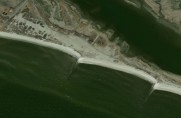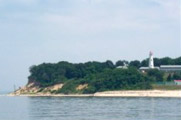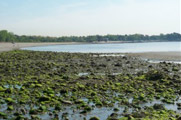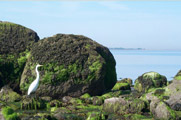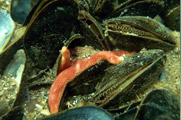Important Coastal Habitat Types
Over the years the abundance and diversity of the Sound’s coastal habitats have been diminished, primarily due to development activities that have destroyed or degraded these important areas. Tidal marshes have been ditched or filled, dams have blocked fish from migrating upstream to spawn, and poor water quality has negatively impacted the Sound’s eelgrass beds. The Long Island Sound Study has identified the loss and degradation of coastal habitat as a priority management issue.
Beaches and Dunes
Beaches and dunes are the transitional sandy or cobble shoreline area between the land and the Sound. These dynamic systems are in a constant state of erosion and deposition due to tidal action, currents, and wind. Dunes can protect adjacent to low-lying properties from flooding. Many rare plants and animals, such as prickly-pear cactus, golden-aster, beach heather, piping plover, and horned lark occur in this habitat complex.
Habitat Restoration Case Study: Dune Restoration, Long beach, Stratford, CT
Long Beach West was once a thriving summer beach community, with 50 privately owned summer cottages on the beach owned by the Town of Stratford. When a bridge connecting the barrier beach was destroyed by fire in 1996, the cottages were condemned by the Town. Restoration of the dunes began in March 2010, the cottages were demolished and removed during the fall and winter season to avoid plover nesting season. Upon cottage removal, the sand was regraded to minimize erosion within the project site. This project was funded in part by the Long Island Sound Study Futures Fund.
Cliffs and Bluffs
Cliffs and bluffs are steep coastal slopes of glacial sands and till that are created through long-term wave erosion and sea-level rise. Rare plant communities, such as New York’s dwarf beech forest, may be found here.
Estuarine Embayments
Estuarine embayments are confined areas of the Sound that have narrow inlets and significant freshwater inflow. They are generally shallower than the open Sound, and the restricted flow causes greater sedimentation.
Their areas are important nurseries for finfish and are concentration sites for wildlife. The best bay scallop production occurs in estuarine embayments.
Habitat Restoration Case study: Manursing Lake, Rye, NY
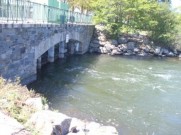
Once an expansive salt marsh, the area now known as Manursing Lake was dredged and impounded in the 1920’s during the development of Playland Amusement Park. After being impounded the manually controlled tide gates allowed irregular flow. This lack of tidal flow in the system has led to problems with anoxia and hypoxia and greatly reduced fish access to the system. After the re-introducing tidal flow through the installation of the 2 self regulating tide gates, tidal wetland plantings were done along a portion of the shoreline. Spartina alterniflora and S. patens were planted in the newly tidal area and will serve as a seed source to expand the vegetation through other appropriate areas in the system. The shoreline was regraded to elevations that are suitable to supporting salt marsh plantings and at a grade to allow a limited amount salt marsh migration in the face of sea level rise in a portion of the planting area. However much of the surrounding land is forested and may allow migration, at least in the area of the nature preserve. This project is located in a Long Island Sound Stewardship Initiative area.
Coastal and Island Forests
Coastal and island forests may be dominated by species such as maple, oak, cedar, pine, and beech. No virgin tracts of old growth forest remain around the Sound.
Animals that may use this habitat include owls, bald eagles, and osprey. Forest stands on islands are of particular importance to nesting colonial water birds, such as egrets and herons, because they are relatively free of predators.
Forests provide shade and oxygen and they influence the local climate.
Habitat Restoration Case Study: Forest Restoration, Alley Pond Park, Douglaston, NY

The origin of Alley Creek is located in a steeply-sloped ravine, though the groundwater flows to sustain constant flow have been greatly reduced by drastic changes in the landscape during area development; with no base flow during dry periods and becoming flashy during storm events. The alterations to the surrounding environment have lead to the project area experiencing intense flooding during rain events, causing sedimentation downstream due to erosion of the sloped areas. The landscape was dominated by invasive plants, mechanical and chemical methods were used in the removal of the nuisance plants. Removing invasives from the headwaters area of Alley Creek is an important step in protecting the integrity of previous projects, as this area served as a seed source of invasive plants. In some cases, Norway maples were girdled, allowing wildlife to use the cavity as nesting habitat. Along the streambank, erosion control fabric was planted with native herbaceous plugs. Native species were replanted by staff and volunteers throughout the project and included Red oak, black oak,pin oak, tulip poplar, sweetgum, silky dogwood and elderberry. This project was partially funded by the Long Island Sound Futures Fund.
Freshwater Wetlands
Freshwater wetlands are the transitional zone between the land and fresh water. There are areas where the water table is at or near the surface of the soil and there is no tidal influence. They are very diverse and may be dominated by trees, such as red maple, shrubs, such as swamp azalea, or herbs, such as cattail. These wetlands aid in groundwater recharge and store flood water. They are also critical habitat to many rare plant and animal species.
Coastal Grasslands
Coastal grasslands are open glacial outwash plains dominated by tall grasses, such as little bluestem and switchgrass. They often have diverse wildflower communities as well.
These areas are critical habitat for many rare and endangered species, such as the grasshopper sparrow and regal fritillary butterfly. Grasslands are also important to birds of prey like the short-eared owl.
Habitat Restoration Case Study: Caumsett State Historic Park Preserve, Lloyd Harbor, NY
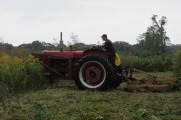
Caumsett State Historic Park Preserve sits on a peninsula on Long Island Sound and has tidal wetland, grassland, forest, bluff, and beach habitats throughout the park. A 25 acre field that had historically had been used as pastureland, had been maintained by New York State Parks as successional fields. An old hedgerow bisected the site, diminishing the value of the existing grassland habitat through fragmentation. Areas of the fields had become dominated by woody plants and invasive plants. Invasive plants that were removed as part of the project included black locust, mile-a-minute, porcelain berry, and mugwort. Removal of the hedgerow, woody plant sections within the field, and invasives allowed contiguous grassland habitat, which will provide greater habitat value to grassland dependent species. Once the invasives were controlled, native grasses and wildflowers were planted in spring 2015, including coastal switchgrass, black eyed susan, and little blue stem. A mowing regime is part of the park’s management of the site and will encourage long term success of the project. Additional project details are available in the habitat restoration database. Partial funding for this project was through the Long Island Sound Futures Fund.
Intertidal Flats
Intertidal flats are shallow areas of bays and harbors that lay between the spring high- and low-tide marks.
These flats contain no rooted vegetation. The sediments may be muddy to sandy and support important species, such as juvenile flounder, clams, and crabs.
Rocky Intertidal Zones
Rocky intertidal zones are areas of exposed bedrock characterized by attached species such as barnacles, algae, and mussels. These zones fall between extreme high- and low-tides, which results in frequent exposure of the resident plants and animals to the air.
The species that attach themselves to this habitat help filter nutrients from the water and are a food source for other marine organisms
Riverine Migratory Corridors
Riverine migratory corridors are river systems that drain to the Sound. They are often bordered by flood plain trees and wetlands. Migratory species, such as Atlantic salmon, shad, and herring, use these rivers to travel to fresh waters miles away from Long Island Sound to spawn. Dams, culverts and other obstructions can block passage for fish to travel from the brackish waters of Long Island Sound to freshwater rivers to spawn. Removing these obstructions is preferable but not always practical. Recreational and commercial fisheries benefit when river corridors remain healthy and passable to migratory fish.
Habitat Restoration CASE STUDY: Branford Water Supply Dam Fishway, Branford, ct
A 16-foot-high town-owned dam was constructed in Queach Brook (a.k.a. Pisgah Brook) during the late 19th century to provide the Town of Branford a public water supply. An aluminum steep-pass was installed on the dam to provide access to spawning habitat. The installation included a housing that contains a fish counter. Native anadromous fish targeted were Alewive and blueback herring. This project was partially funded by the Long Island Sound Futures Fund.
Submerged Aquatic Vegetation Beds
Submerged aquatic vegetation beds are comprised of rooted plants, such as eelgrass and widgeon grass, which grow on shallow bay bottoms below the spring low-tide mark. These grassy beds provide vital refuge for juvenile fish and lobsters. The plants also trap sediments and use nitrogen from the water column, thereby improving water quality.
Habitat Restoration Case Study: Terrys Point Eelgrass Restoration, Southold, NY
After the coastwide eelgrass dieoff in the 1930’s, much of Long Island Sound’s eelgrass never recovered. The site was chosen due to geographic similarities to Mulford Pt. a natural meadow that also served as a reference meadow. Eelgrass surveys funded through the Long Island Sound Study have found natural eelgrass meadows in areas previously thought to be unsuitable, whether too rocky or in areas with seemingly rough currents. Cornell Cooperative Extension (CCE) researchers developed a rock transplant method to encourage successful establishment of eelgrass (Zostera marina) shoots. Donor meadows included Mulford Pt., Fishers Island and Orient Point. Test plantings occurred in 2005, with more intensive plantings occurring in 2006 through 2008. The plantings have successfully expanded to densities exceeding those found in natural beds. This project was partially funded by the Long Island Sound Futures Fund.
Shellfish Reefs
Shellfish reefs are formed by clusters of oysters and blue mussels. The reef structure sites on top of soft sediments and provides habitat and shelter for a variety of other finfish and invertebrate species. The shellfish are able to filter algae and particulate matter in the water column thereby improving water quality.
Tidal Wetlands
Tidal wetlands are the transitional zone between the land and submerged systems. These areas are dominated by rooted plants that are flooded by the tide. Healthy wetlands help trap sediments, store flood water, and reduce wave energy during storms. Two-thirds of all marine species depend on tidal wetlands for a portion of their life cycle.
Habitat Restoration CASE STUDY: Little River Tidal Marsh, New Haven, CT
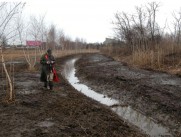
In 1997, six 48 inch diameter culverts were installed in a remnant berm to increase tidal flow to more than 100 acres of brackish marsh. Previously the marsh was dominated by non-native Phragmites australis. To further restore the hydrologic connection to tidal waters, portions of the berms were removed in 2010 to facilitate enhanced tidal flushing and allowed the marsh to drain appropriately during low tide cycles. Locations of berm cuts were based on historic channel locations. This project was funded by the Long Island Sound Futures Fund.
